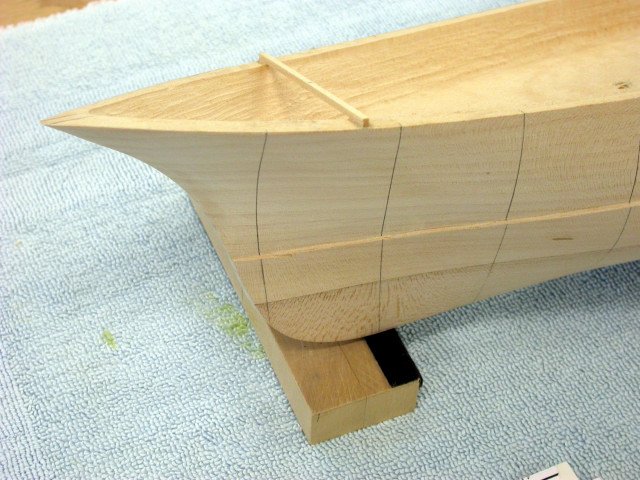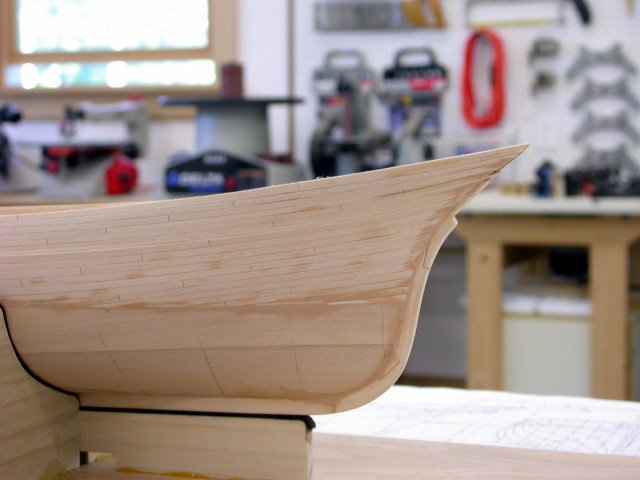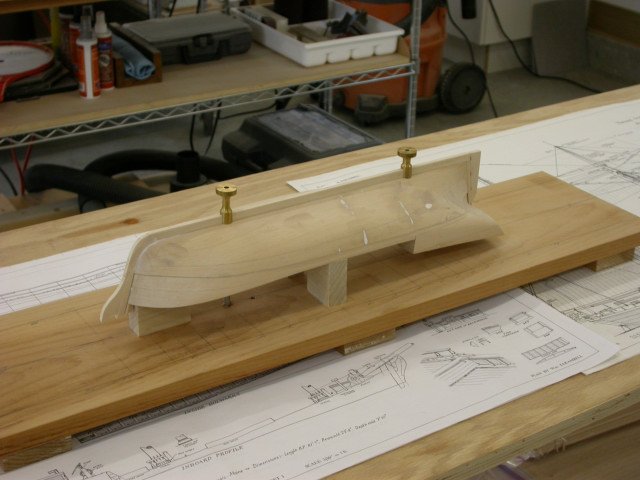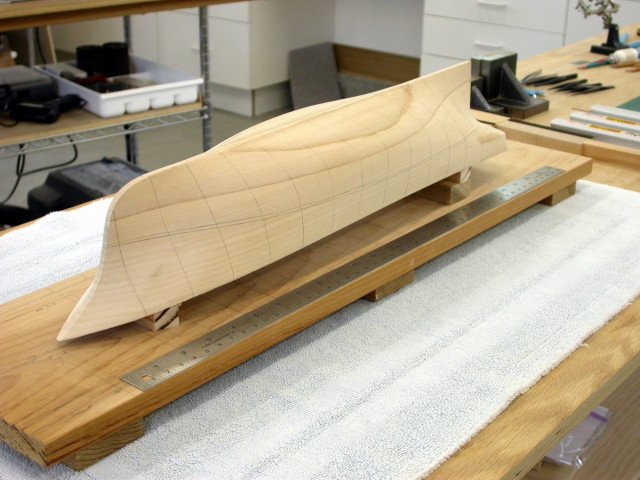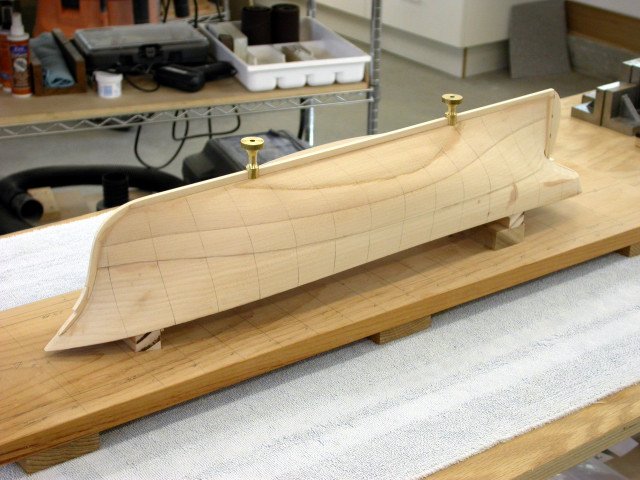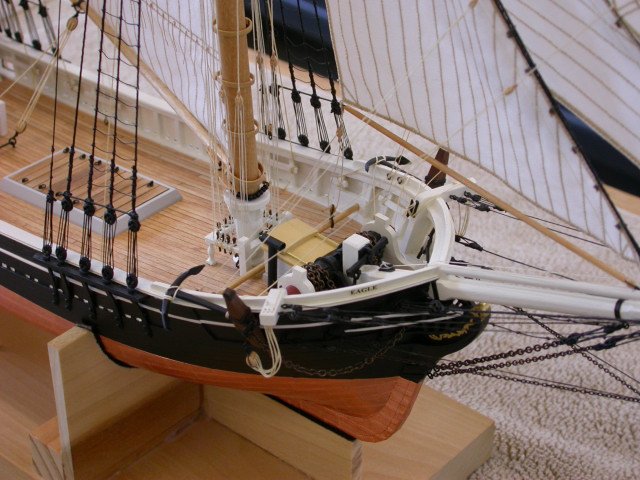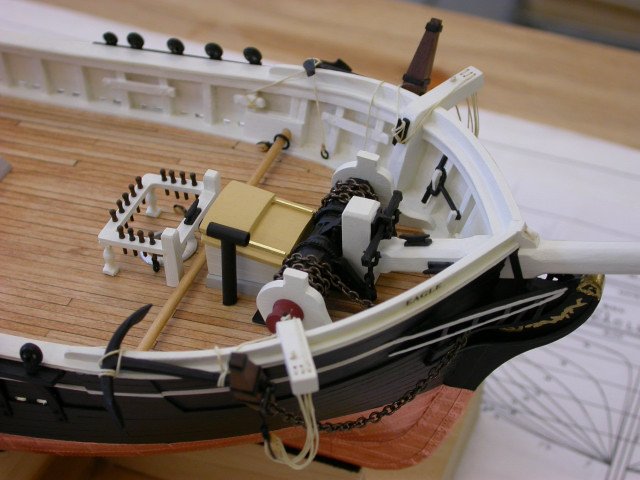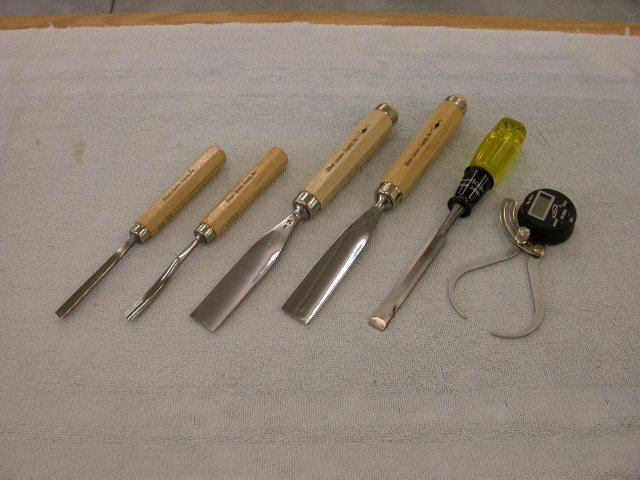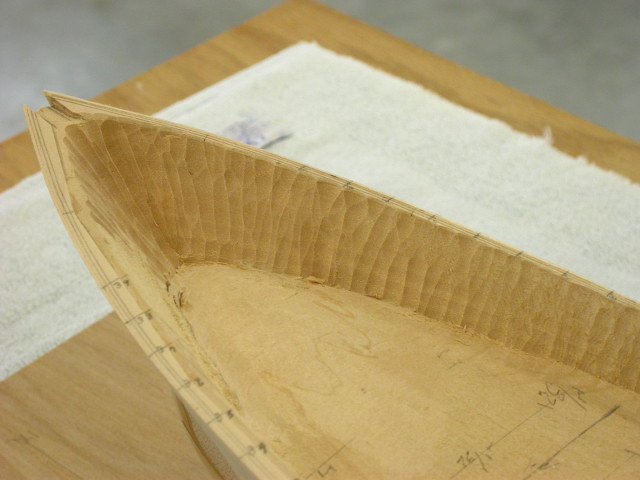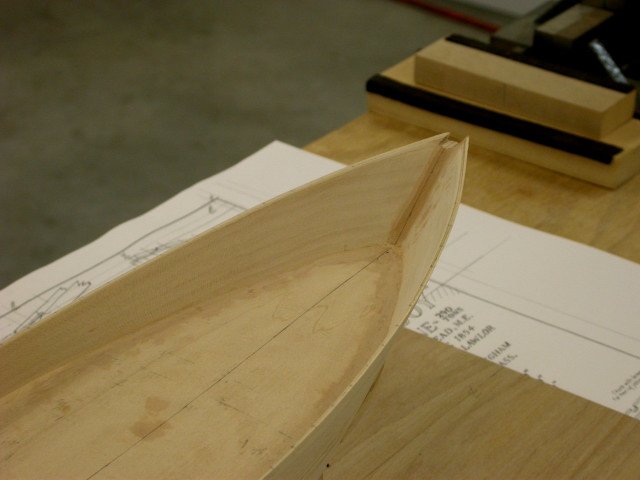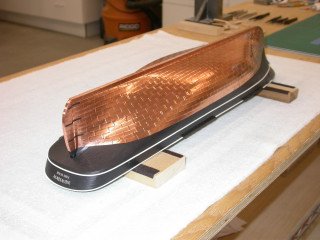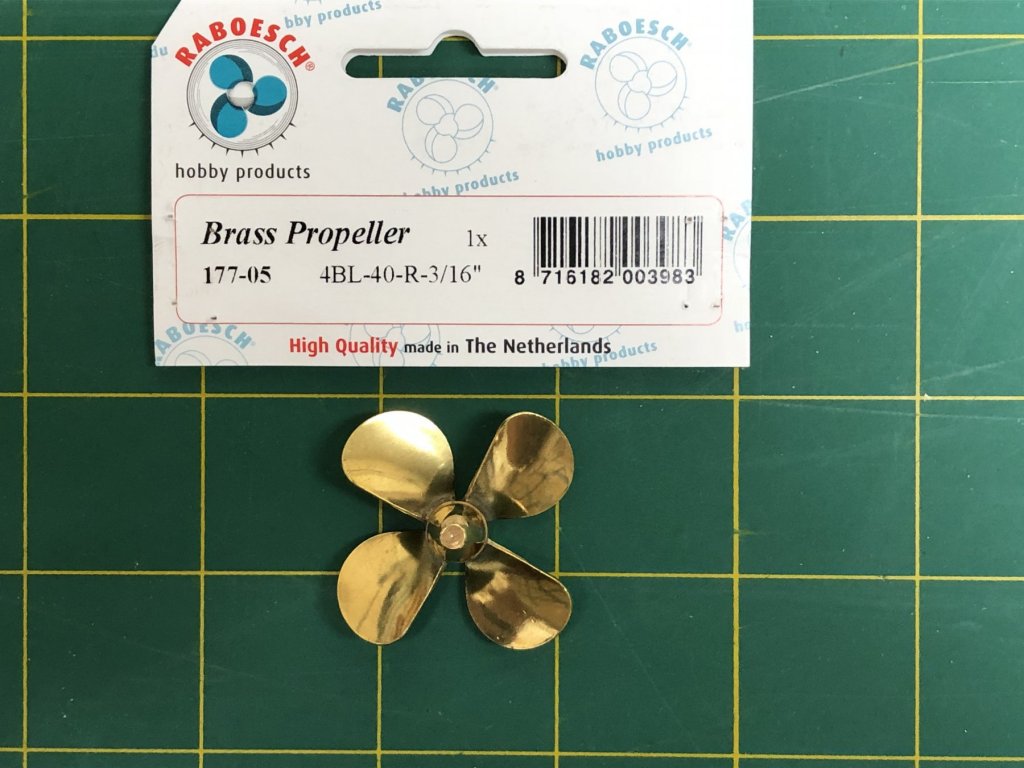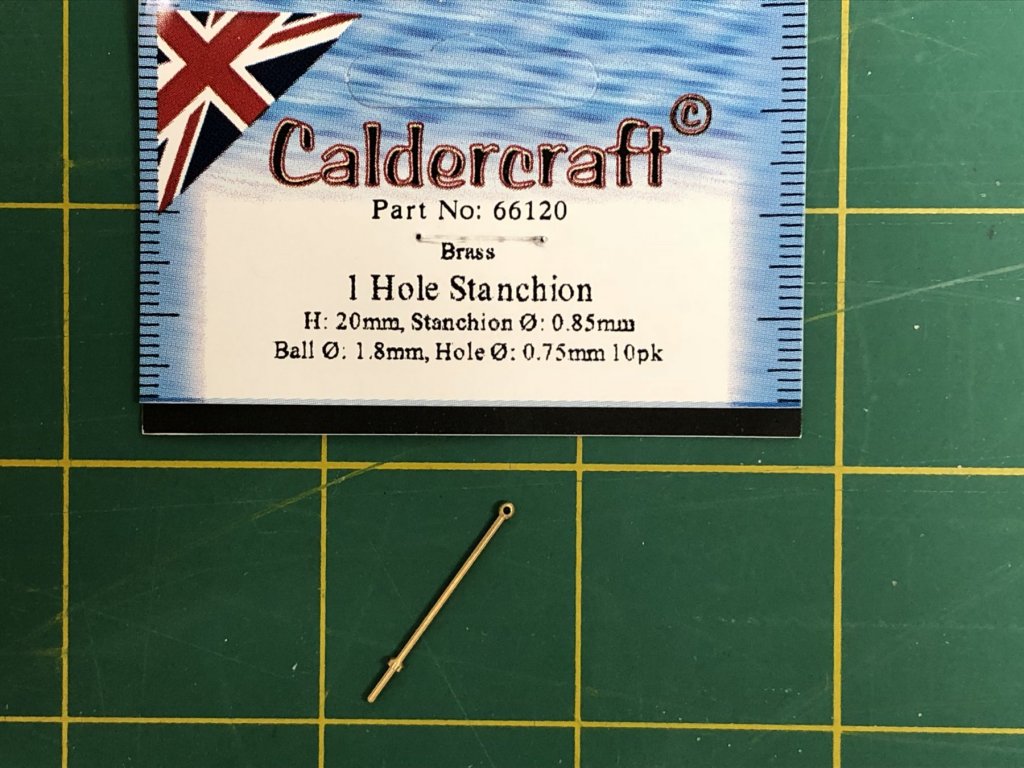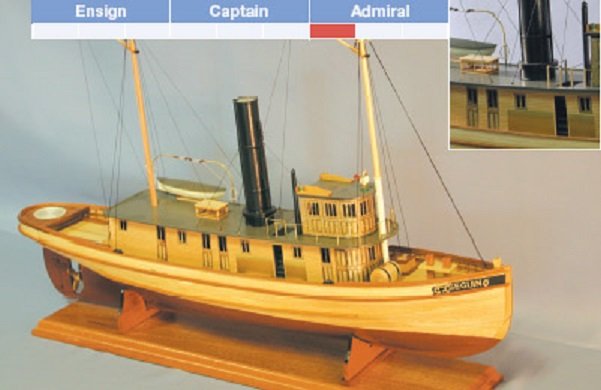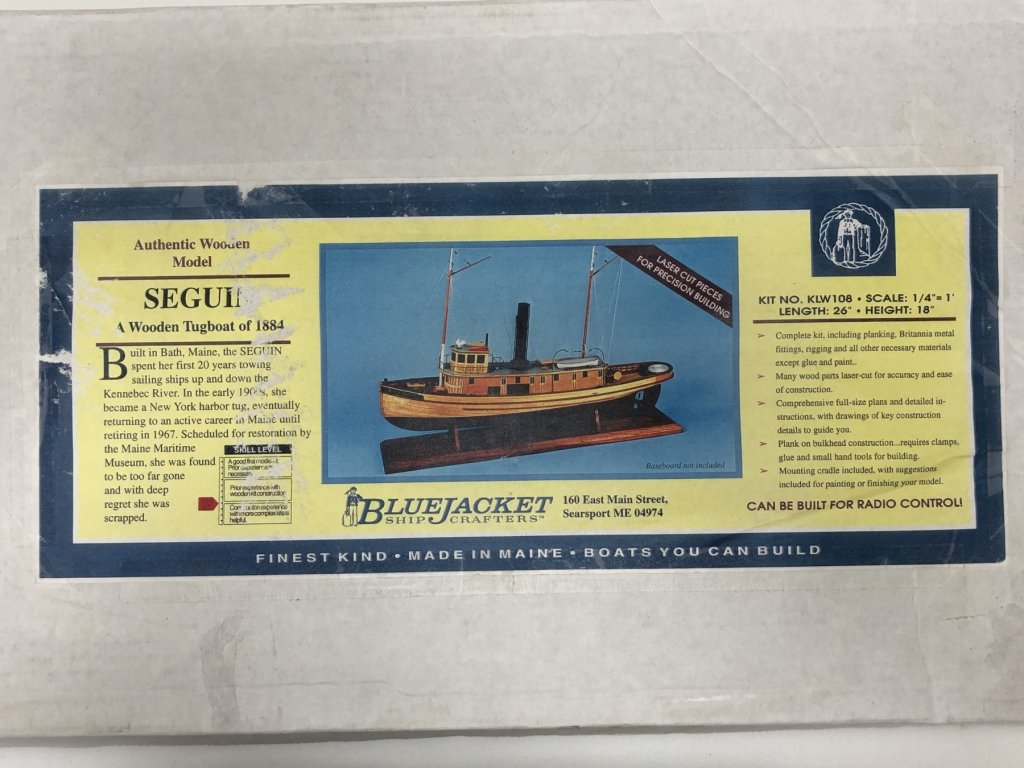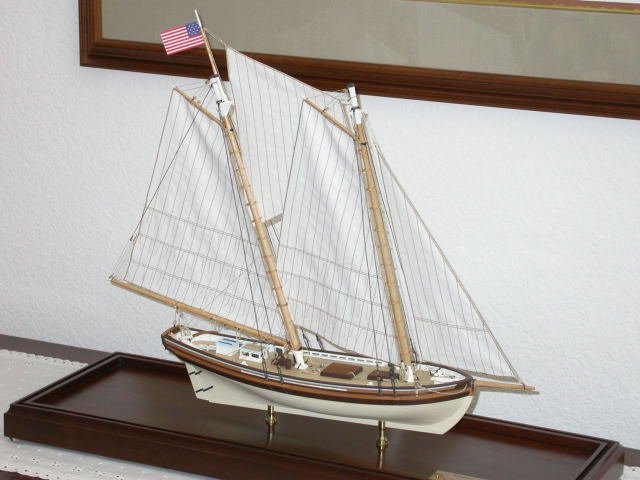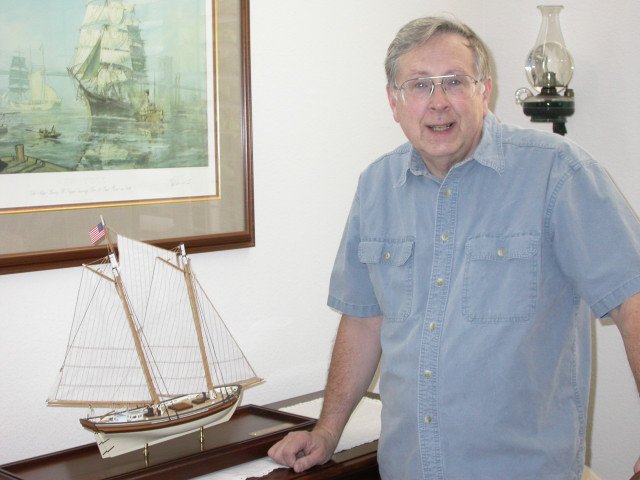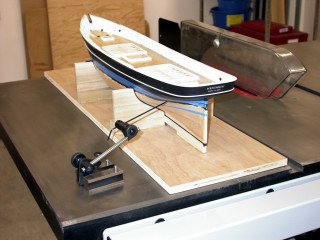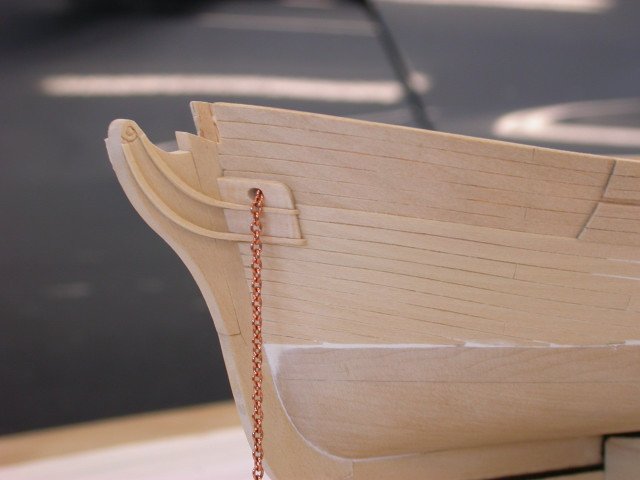-
Posts
343 -
Joined
-
Last visited
Content Type
Profiles
Forums
Gallery
Events
Everything posted by Pete Jaquith
-
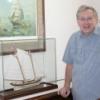
Model Ship Ways Solid Hull Flying Fish
Pete Jaquith replied to jaybeckham's topic in Wood ship model kits
Jay, Roger makes an important point re datum lines. In my technique, I secure the hull in the inverted position to a reference board and all profile and station templates use the top surface of this reference board as a common baseline. This is shown in the above Eagle and Newsboy pictures. -

Model Ship Ways Solid Hull Flying Fish
Pete Jaquith replied to jaybeckham's topic in Wood ship model kits
Jay, For my 3/16" scale Newsboy I used 3/64"x 1/8" hull planking and 1/32" x 3/32" bulwark planking giving a small step at the plankshear. You will see in my notes that I recessed the topside by 3/64" to accommodate this. Either way, I think you will be pleased with the result. -

Model Ship Ways Solid Hull Flying Fish
Pete Jaquith replied to jaybeckham's topic in Wood ship model kits
Jay, They should show up if you use the search function here on MSW. -

Model Ship Ways Solid Hull Flying Fish
Pete Jaquith replied to jaybeckham's topic in Wood ship model kits
Jay, Personally I prefer solid hulls. My build logs and instructions here on MSW document my practice for carving and then planking the topsides for solid hulls. You can check out the following: Plank on Solid ship Model Hulls Maine Topsail Schooner Eagle of 1847 build log Brigantine Newsboy of 1854 build log -
Personally, I prefer plank on solid (POS) to plank on frame (POF) construction. I have used both machine carved kit hulls and laminated scratch built hulls. The following notes apply: Machine Carved Hulls Requires care in establishing reference lines May require hull, deck, and/or bulwark build up Hull carved inverted using reference board and templates Hull initially carved to outer plank lines Upper hull recessed for 3/64" planking, lower hull coppered Thinning carved bulwarks requires care, they may be replaced with built up bulwarks Reference my Brigantine Newsboy build log on MSW Laminated Scratch Built Hulls Ease in establishing/maintaining reference lines Maintain rectangular configuration until completion of deck carving, deck layout, and drilling of mast holes Hull carved inverted using reference board and templates Hull initially carved to outer hull lines Upper hull recessed for 3/64" planking, lower hull coppered Requires built up bulwarks with timberheads slotted into hull block Reference my Topsail Schooner Eagle build log on MSW I find both techniques work well and require ~ 60 hours for hull carving Regards, Pete
- 356 replies
-
- red jacket
- finished
-
(and 1 more)
Tagged with:
-
Always enjoy mid 1800's merchant sail. I will be following along. Pete
- 356 replies
-
- red jacket
- finished
-
(and 1 more)
Tagged with:
-
After an inquire on my ship modeling projects, I thought it best that I provide an update on my ship modeling plans. My loving wife Linda, our two dogs, and I are now located in the beautiful retirement community Sun City Shadow Hills in Indio, CA. My ship models made the two moves without damage and I have recently completed set up of a ship model shop in the garage. Once my garage cools off, ship model projects planned for the future include: Steam Tug Seguin of 1884 – new build based on ¼” scale Bluejacket kit Brigantine Newsboy of 1854 – complete 3/16” scale semi-scratch build 16 Gun Brig Fair American, circa 1780 – complete ¼” scale build based on MS kit Whaling Brig Kate Cory of 1856 – new build based on 3/16” scale MS kit Regards, Pete
-
jfinan, Very nice build. I like your approach to planking a solid hull (POS). This is my approach as illustrated in my Topsail Schooner "Eagle" and Brigantine "Newsboy" builds.
- 104 replies
-
- constitution
- BlueJacket Shipcrafters
-
(and 1 more)
Tagged with:
-
Jfinan, Once you have removed the bulk of the bulwark material, flexible sanding sticks (from the beauty salon) are very helpful in finishing the inner surface. Pete
- 104 replies
-
- constitution
- BlueJacket Shipcrafters
-
(and 1 more)
Tagged with:
-
Jfinan, I have attached pictures of this stage in my Newsboy build here in MSW. I used sharp gouges to carve vertically and remove excessive bulwark material. A dial caliper was used to monitor thickness. Pete
- 104 replies
-
- constitution
- BlueJacket Shipcrafters
-
(and 1 more)
Tagged with:
-

1:64 Copper plating
Pete Jaquith replied to Peter Y.'s topic in Building, Framing, Planking and plating a ships hull and deck
My prior post describes my experience installing copper sheathing on my Topsail Schooner "Eagle" and Brigantine "Newsboy" models. I used copper tape and at 3:16 scale do not recommend embossing.- 14 replies
-
- pickle
- caldercraft
-
(and 1 more)
Tagged with:
-
Steam Tug Seguin of 1884_2_Construction Planning The model will be built to a scale of 1/4” to the foot (1:48) based on a Bluejacket Ship Crafters kit. The model is plank on bulkhead (POB) construction, with built up bulwarks, planked decks and topsides, and scratch-built deck furniture/fittings. The model will be constructed as a static model using kit furnished materials and largely following the Bluejacket kit construction sequence. Key observations and exceptions identified to date include: · Hull planking layout will be simplified following the kit instructions. · Decks will be built without camber (a departure from prototype practice). This follows the kit instructions and will simplify deckhouse construction. · Main deck will be individually planked following prototype practice. · Upper decks will be canvas covered following prototype practice. · Propeller has been replaced with a four bladed brass propeller from Caldercraft. · Rail stanchions have been replaced by turned brass stanchions from Caldercraft. · Model will be painted with color scheme typical for the period. Next step will be a detailed review of the drawings and preparation of a construction sequence outline following my normal practice. Regards from the shipyard, Pete Jaquith
-
Steam Tug Seguin of 1884_1_Description The steam tug Seguin was built in 1884 by the B.W. & B.F. Morse Shipyard in Bath, ME, for the Knickerbocker Steam Towage Company. Named for an island at the mouth of the Kennebec River, Seguin was 88.1 feet long and had a beam of 19.8 feet. Originally powered by a 26” x 26” surface condenser engine, she was re-engined in 1909 with a 275 shp compound triple expansion engine giving her a top speed of 12 knots. She carried a crew of seven, including the captain, mate, engineer, two firemen, a cook, and a deck hand. For the first twenty years of her 85-year career, Seguin towed wooden sailing ships up and down the Kennebec River in the summer. In the winter, she towed barges laden with coal, lumber, and ice to ports along the Atlantic coast of the United States. For the next ten years, Seguin worked along the Hudson River for Cornell Towing Company of New York. After that, she spent the remainder of her career serving the ports of Maine until her retirement in 1967. The model will be built to a scale of 1/4” to the foot (1:48) based on a Bluejacket Ship Crafters kit. The model will be plank on bulkhead (POB) construction, with built up bulwarks, planked decks and topsides, and scratch-built deck furniture/fittings. The steam tug Seguin will be a fitting companion for my series of mid 1800’s American merchant sailing ship models and a visual reminder of the small steam tugs I sailed on with my father as a teen-ager. Regards from the shipyard, Pete Jaquith
-
I have recently completed installation of a work bench, peg boards, lighting, and unpacked ~12 boxes of tools. I also installed an evaporative cooler, or swamp cooler to control garage/shop temps when it is 100-115 degrees outside.
-
After five years working on full-scale shipbuilding projects, two home moves, and with a reduced level of shipbuilding consulting work I now find time to return to ship modeling. Over the past few years I have enjoyed this opportunity to work on a wide variety of naval destroyer, naval auxiliary, icebreaking, research, and commercial shipbuilding projects and with a number of industry professionals. My loving wife Linda, our two dogs, and I are now located in the beautiful retirement community Sun City Shadow Hills in Indio, CA. My ship models made the two moves without damage and I have recently completed set up of a small ship model shop in the garage. Ship model projects planned for the near future include: Steam Tug Seguin of 1884 – new build based on ¼” scale Bluejacket kit Brigantine Newsboy of 1854 – complete 3/16” scale semi-scratch build 16 Gun Brig Fair American, circa 1780 – complete ¼” scale build based on MS kit Whaling Brig Kate Cory of 1856 – new build based on 3/16” scale MS kit As these projects get underway, I plan to develop/restart build logs here on Model Ship World. Regards from the shipyard, Pete Jaquith
-
Thank you for your interest and support. Over the past few years I kept busy supporting a number of full scale ship building projects in both the US and Canada. While continuing my shipbuilding consulting business, Linda and I recently completed a move to Indio, CA. With my shop setup nearing completion, I plan to return to woodworking and ship modeling in the coming months. Currently planned projects include: Steam Tug "Seguin" 1:48 scale built in Bath, ME in 1884 (Bluejacket kit) Restart of my Brigantine "Newsboy" 1:64 scale built in 1854 (semi-scratch from Model Shipways kit) Restart of my Brig "Fair American" 1:48 scale circa 1780 (semi-scratch from Model Shipways kit) Restoration of family antique tables Regards, Pete, Shipbuilder
-

MS Katy of Norfolk kit issues and parts replacement
Pete Jaquith replied to kearnold's topic in Wood ship model kits
Kearnold, As Chuck has noted, your Katy is typical of the old solid hull kits that used to be common in our hobby. Don't give up, you can still build a fine model as I believe that MS has provided a fine set of plans prepared by Jim Roberts. If you send me your e-mail by private message, I will send you my notes, block lists, rigging schedules, etc. from my build. Note the Katy model pictured below was my 1st wooden ship model built in 2006.- 14 replies
-
- schooner
- katy of norfolk
-
(and 4 more)
Tagged with:
-
Rusty, Very fine example of ship model art. Also a very good kit prepared by Chuck. Regards, Pete
- 310 replies
-
- cheerful
- Syren Ship Model Company
-
(and 1 more)
Tagged with:
-
Modeler Bob, Several years ago I laid up my Brigantine Newsboy 1854 and 14 Gun Brig Fair American circa 1780 to pursue a series of full scale shipbuilding projects. I have since relocated to Indio CA. Once we get the house set up I hope to establish a small shop in the garage. Although I continue to support full scale shipbuilding programs, I hope to have more time at home and plan to pick up construction of the afore mentioned models. Regards, Pete Shipbuilder
-
Modeler Bob,
Newsboy is currently in layup awaiting my return to modeling. I have been busy with full scale shipbuilding projects and a recent move to Indio, CA. I hope to pick up Newsboy construction in the coming months.
Regards,
Pete
-
Ken, Nice looking model. I agree that the furled sails add a new dimension to the model. Regards, Pete
- 481 replies
-
- rattlesnake
- model shipways
-
(and 1 more)
Tagged with:
-
Steve, Good to see another solid hull build log. I prefer Plank on Solid (POS) construction for its accuracy and providing a solid support for planking. For ships with copper sheathing I recess the upper hull to accommodate hull planking. This picture is from my Topsail Schooner EAGLE 1847 build log. Regards, Pete
About us
Modelshipworld - Advancing Ship Modeling through Research
SSL Secured
Your security is important for us so this Website is SSL-Secured
NRG Mailing Address
Nautical Research Guild
237 South Lincoln Street
Westmont IL, 60559-1917
Model Ship World ® and the MSW logo are Registered Trademarks, and belong to the Nautical Research Guild (United States Patent and Trademark Office: No. 6,929,264 & No. 6,929,274, registered Dec. 20, 2022)
Helpful Links
About the NRG
If you enjoy building ship models that are historically accurate as well as beautiful, then The Nautical Research Guild (NRG) is just right for you.
The Guild is a non-profit educational organization whose mission is to “Advance Ship Modeling Through Research”. We provide support to our members in their efforts to raise the quality of their model ships.
The Nautical Research Guild has published our world-renowned quarterly magazine, The Nautical Research Journal, since 1955. The pages of the Journal are full of articles by accomplished ship modelers who show you how they create those exquisite details on their models, and by maritime historians who show you the correct details to build. The Journal is available in both print and digital editions. Go to the NRG web site (www.thenrg.org) to download a complimentary digital copy of the Journal. The NRG also publishes plan sets, books and compilations of back issues of the Journal and the former Ships in Scale and Model Ship Builder magazines.



